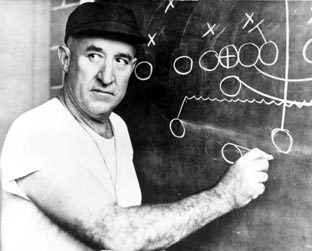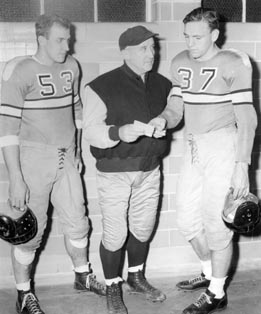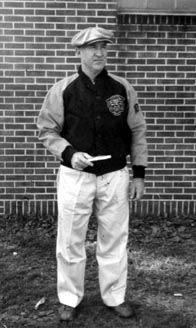Football Alums Pay "Tribute to a Beloved Coach" in New York Times
October 8, 1983
 October 8, 1983, Greencastle, Ind. - "Fifty years after the fact, Chester Elson can conjure up the sensations of sleeping in the fieldhouse at DePauw University in Greencastle, Ind., earning a dollar a day as night watchman and some spare change mowing his football coach's lawn and baby-sitting for his coach's children," writes Jane Gross in today's New York Times. "It was 1933, during the Depression, yet Elson had a dream that was fed and furthered by Raymond Neal, the coach of the football team that went undefeated, untied and unscored upon that year." The story, headlined "Tribute to a Beloved Coach," includes the photo of Coach Neal that accompanies this summary.
October 8, 1983, Greencastle, Ind. - "Fifty years after the fact, Chester Elson can conjure up the sensations of sleeping in the fieldhouse at DePauw University in Greencastle, Ind., earning a dollar a day as night watchman and some spare change mowing his football coach's lawn and baby-sitting for his coach's children," writes Jane Gross in today's New York Times. "It was 1933, during the Depression, yet Elson had a dream that was fed and furthered by Raymond Neal, the coach of the football team that went undefeated, untied and unscored upon that year." The story, headlined "Tribute to a Beloved Coach," includes the photo of Coach Neal that accompanies this summary.
"He'd come out to the fieldhouse just about every night and talk to me for an hour, an hour and a half," Elson, a 1936 graduate of DePauw, tells the newspaper. "He'd tell me that when you come out of school in this country you can do anything you want.  That's what he sold me on. Firstly, he was a great coach, but he was a great human being, too. When I start talking about him I get tears in my eyes."
That's what he sold me on. Firstly, he was a great coach, but he was a great human being, too. When I start talking about him I get tears in my eyes."
Over the years, those who played for "Gaumey" Neal "have remained close and have held frequent reunions, spurred by their feeling for their coach, who died in 1977," Gross writes. "In 1979 they mounted a fund-raising drive and in 60 days came up with $2.2 million toward the construction of the Raymond Neal Fieldhouse. This weekend, they are celebrating the 50th anniversary of the perfect season at DePauw's homecoming, and they expect an extraordinary turnout: Of the 40 students on the 1933 team, 35 survive, and 27 will attend the reunion, along with two players' widows and Genevieve Neal, the coach's widow."
C. Norman Frees '36, who started at left halfback on the 1933 team, says Neal "went out of his way to keep us all in school in hard times. He helped us scrounge jobs, setting up pins in a bowling alley, waiting tables.  I fired the furnace at a sorority house and was a caretaker at an undertaking establishment. Well, some of us prospered and want to do this in his memory," Frees tells the Times.
I fired the furnace at a sorority house and was a caretaker at an undertaking establishment. Well, some of us prospered and want to do this in his memory," Frees tells the Times.
"He was interested in each one of those boys," Mrs. Neal says. "He'd check up on every one of them after each game, not just to see if they were all right physically, but to see if they had something to eat that day. We didn't have much either, but they were always welcome to come eat with us at the farm or mow the lawn for 10 cents an hour. It was our greatest joy to have them."
Access the complete article at the newspaper's Web site (a fee is required).
Ten years ago, Coach Neal and his former players were honored at a special Old Gold Day luncheon marking the 40th anniversary of their historic season.
Learn more about Neal Fieldhouse and the Lilly Center here.
Source: New York Times
Back